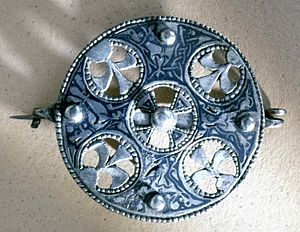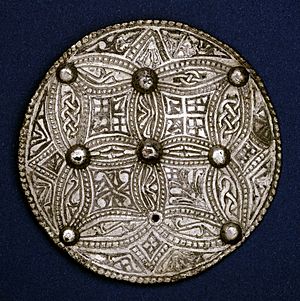Beeston Tor Hoard facts for kids
The Beeston Tor Hoard is a special collection of Anglo-Saxon jewelry and coins. It was found in 1924 at Beeston Tor in Staffordshire, England. This amazing treasure includes 49 coins, two silver brooches with fancy designs, three finger rings, and some other small pieces. Experts believe the hoard was buried around the year 875 AD.
Contents
Discovering the Treasure
The Beeston Tor hoard was found by a man named Rev. George H. Wilson in 1924. He discovered it in a cave called St. Bertram's Cave. This cave is on a tall limestone cliff at Beeston Tor in Staffordshire, England.
The hoard was found quite close to where a Viking army camped in 873-874 AD. This makes people wonder if the hoard is connected to the Viking invasion. The treasure included 49 Anglo-Saxon pennies, three gold rings, two silver brooches, and other small items.
Wilson wrote about his discovery in a book published in 1926. He mentioned finding the items loose, with traces of skin or leather. This suggests the jewelry and coins might have been kept in a bag or purse.
What Was Found?
Ancient Coins
The hoard contains 49 Anglo-Saxon pennies from the 800s. The newest coins were made just before 875 AD. Twenty of these coins were from King Burgred of Mercia. He ruled from 853 to 874. Another 20 coins were from Alfred the Great of Wessex, who ruled from 871 to 886.
The other nine coins were also from important leaders. Seven were from Æthelred I, King of Wessex (865-871). One coin was from Archbishop Ceonolth of Canterbury (833-870). The last coin was from Æthelwulf, King of Wessex (839-858).
Beautiful Brooches
The hoard included two silver brooches. They show the amazing Trewhiddle style of Anglo-Saxon art from the 800s. This style often uses silver with black niello inlay. It features detailed carvings of animals, plants, and geometric shapes.
Each brooch shows different parts of the Trewhiddle style. The smaller brooch has a complex openwork design. It features animal shapes. The larger brooch is simpler. It is a flat disc with abstract patterns.
The smaller brooch has an openwork design with a dark niello background. It has a beaded edge and a cross shape in the middle. This cross has raised decorations called bosses. Animal shapes with beaked heads are part of the design. These animal designs are unique and mixed with swirling lines and ivy patterns.
The second, larger brooch is a flat silver disc. It has simpler abstract designs. The brooch has four circles that cross each other. Nine small bosses are evenly spaced and connected by pointed oval shapes. Its decoration includes simple swirling lines, plants, and geometric symbols.
Rings and Other Items
Three finger rings were also part of the hoard. One was a gold finger ring with a diamond-shaped cross-section. Two others were copper-alloy wire rings; one of these was broken.
A copper-alloy binding was also found. It was a bent piece of metal with a beaded edge. It narrowed to a rounded end. This end had one rivet, and two other rivets were where the piece narrowed.
See also



